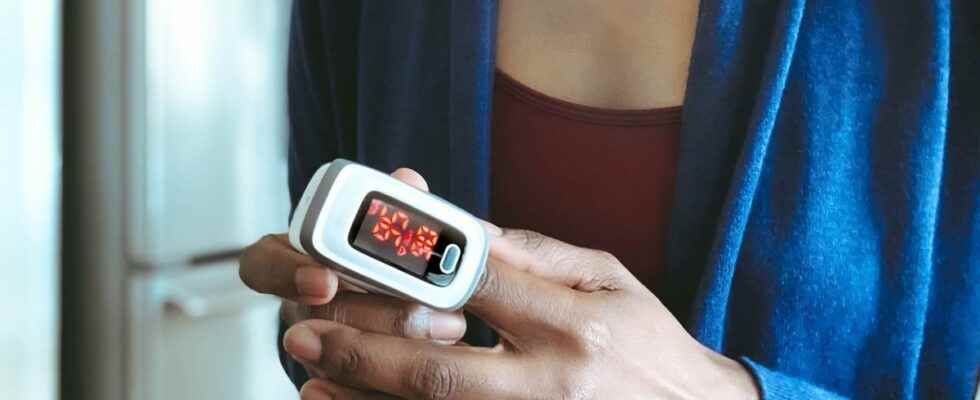Published ,
Reading 3 mins.
in collaboration with
Dr Gérald Kierzek (Medical Director of Doctissimo)
With the Covid-19 pandemic, some people have got into the habit of monitoring their saturation, especially during their convalescence. Where can I get a pulse oximeter? How to choose and use it? Advice from Dr Gérald Kierzek, emergency doctor and medical director of Doctissimo.
The Covid-19 pandemic has made us adopt new reflexes. Among them, having a saturometer at home and measuring your oxygen saturation level when you are sick. “A tool, the use of which must become commonplace, in particular for self-monitoring in the event of Covid” believes Dr. Kierzek. An opinion that is in line with a study published by researchers from Imperial College London, which indicates that “Measuring blood oxygen levels at home is a safe way for people with COVID-19 to spot signs that their health may be deteriorating.”.
What is oxygen saturation?
The oxygen saturation rate corresponds to the quantity of oxygen transported by the blood in our organism. Oxygen is essential for the proper functioning of the human body. This is transported by the blood by the red blood cells, before being distributed to the various organs.
For Dr. Kierzek, saturation is “a constant that you can monitor yourself at home, but without falling into paranoia”. For this a small device, called saturometer or pulse oximeter, is placed at the end of the index. “Thanks to an infrared system, it thus evaluates the oxygenation almost of the whole body”explains Dr. Kierzek.
When to measure its saturation? What are normal numbers?
The figures for normal oxygen saturation are estimated between 95% and 100%, we speak of hypoxemia below 95% and desaturation below 90%. “The advantage of trivializing this self-monitoring is that a person who is affected by a pulmonary pathology, for example, will be able to recognize his average level of oxygen in the blood. adds the specialist, who recommends regular measurement for a chronically ill person and up to three measurements per day during isolation for Covid.
“This makes it possible to detect happy hypoxias: this is when patients are affected by hypoxia but have no symptoms. This allows them to notify their doctor quickly, before the saturation drops too much.” adds the doctor again.
Where can I get a pulse oximeter?
For Dr. Kierzek, the pulse oximeter must therefore be part of everyday life, like thermometers, and end up in the first aid kit. To get one, you can choose to go to a supermarket or a pharmacy, “with a health professional who can give you additional advice, which is always useful” says Dr. Kierzek. “It’s not expensive, it costs around twenty euros on average and it can pay off.” concludes the doctor.
Our selection of oximeters:
The most famous: Beurer PO 45 pulse oximeter
This Beurer pulse oximeter measures your oxygen saturation, your heart rate (pulse), and your perfusion index (PI). Easy to use and painless, it is equipped with a screen and 7 display formats. It is particularly useful for people who suffer from respiratory diseases, but also for athletes. It is ideal for sports at altitude such as skiing or mountaineering.
Our opinion :
This pulse oximeter without blood sampling is convenient and easy to carry. It can be used both at home and outdoors and can effectively measure the oxygen content of your body.
The most professional: AGPTEK Professional Fingertip Oximeter
This professional oximeter has an autonomy of 32 hours. To use it, nothing could be simpler, just insert your finger and then press the power button. 10 seconds later, the screen displays an accurate result showing the blood oxygen saturation level and pulse rate. It turns off automatically after use.
Our opinion :
Both quick and easy to use, this oximeter is sold with batteries, a carrying case and a user manual. He is therefore immediately ready to use it. In addition, its battery lasts 32 hours and it guarantees 5 years.
Consult a GP online
The most classic: Pulse oximeter YK-81CEU from Braun
Measuring oxygen saturation and heart rate has never been easier. This oximeter is equipped with a backlit and rotating display to read the results with greater clarity. It is sold with AAA batteries and turns off after 8 seconds of inactivity.
Our opinion: Simply slide the oximeter on your fingertip to get an accurate result as in the clinic and does not require a blood test. The rotating screen is an asset that provides more comfort and facilitates the reading of the result. It is recommended for people suffering from respiratory diseases as well as athletes.
